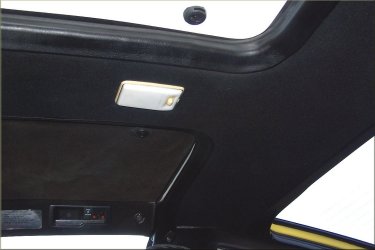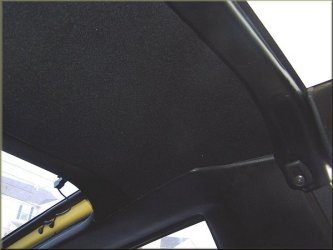Replace/Repair Headliner
On my 86 Turbo, which already had a pretty nice interior, one typical problem existed. I didn't even notice or check the headliner while purchasing (not that it would've made a difference). I noticed it first when I was going around with protectant wipes getting all the plastic cleaned up. Well - typical sagging had occurred somewhere in it's life. Someone tried once or twice to get it stuck back up there, but when the foam backing is basically powder, it doesn't stick well.
I read the Z31 article about removing the headliner, and AZ-ZBum's writeup about replacement and I went to town. Removal of the headliner is a cinch and takes maybe 10 minutes tops. The most difficult part was removing the rear trim piece, which isn't saying much because that wasn't too tough, either.
Cost of Repair: $15 for Headliner Fabric and $15 for 3M Spray Adhesive (I've seen it cheaper online)
The surface of the original headliner was still in pretty good shape. However, certain sections had warped and the foam backing was pretty much destroyed around the back edge because of heat, age, and multiple applications of glue. Some glues will dissolve foam and most glues will not adhere an old Z headliner to the hardboard backing. The original headliner has a velvet-like surface which is bonded to what appears to be a plastic liner, all with a foam backing. Once the foam is gone, the plastic is all the glue has to stick to, and the padding is obviously gone, which would case a gap between the trim and headliner surface. So, basically, the best thing you can do it replace the headliner instead of trying to get it to stick back on...even if you did a good job, you'll likely have some warped sections and end up with a sagging headliner again in the near future.
I removed the metal clips from the holes --- this was a bit of a pain. Obviously be careful not to bend the hard board because it will crack or break off. You want these metal clips put back on after you adhere the new fabric. One of them accepts the clips from the map-lights so you won't wear into the hardboard by clipping the metal clips into the hardboard opening.
Worse than anything was the ATTEMPTS previous owners took
on rehanging the original liner. They got glue everywhere. I had to
refinish the hatch trim piece because the glue would not come off
without stripping paint. I stripped it clean and repainted it with black
trim paint from Checker. Looks great : ) Back to the main subject,
however --- many small sections of headliner did not rip off with the
rest of the headliner. It was glued on tight. There were several
sections on the board that had thick, heavy glue. I had to take a razor
blade scraper and carefully get the bulk of it off. Be careful if you
have to do this because the blade will easily start to cut into the
hardboard. It took me about 90 minutes to clean off the bulk of the
glue. Then I used an orbital sander to even things out as good as I
could without ruining the shape or thinning out the board too much. I
used some citrus cleaner on some of the sticky glue residue that was
left over. There as both sticky, wet glue residue and hard stuck on
glue.
As described in the write-ups, any normal sections with
stuck on old foam were easy to work with. Just rub it off with a medium
coarse scotch-pad. I tried to remove any "high" areas where glue was a
bit thicker. When done, the majority of the surface had a uniform rough
look (except for the part I had to sand). I took 200 grit wet sand paper
(used it dry) and just went over the entire surface lightly to clean it
off and get a good bonding pattern for the new glue.
I went to Jo-Anns Fabric and bought the black, foam-backed
headliner. Hopefully the foam used now is a bit more resilient that the
foam backing used on the original headliner. There is not a plastic
liner, at least, so if it ever sags again, reparation might be possible
(thought the gap would still be an issue with repair). Cloth may also
shrink over time (maybe not warp, but shrink).
Although both the write-ups above are great, I followed
this one a bit more closely:
HEAD LINER
REPAIR
I did not want to use staples, and I figured a
well-adhered headliner is not going to need staples to keep it up. I
found several spray adhesives at Checker, AutoZone, and HomeDepot.
However, none of them were high-heat resistant. Basically all of them
said they were for automotive fabric and carpet, but not to be used for
headliner. Even some that said they were specifically for headliner
basically said not to use them for headliner : ) One 3M can was labeled
as General Purpose Spray Adhesive. It said not to use it for headliner,
but rather to use 3M™ Super Trim Adhesive. I found this stuff at NAPA,
along with several other suitable spray adhesive products (all high heat
resistant). The can said 3M Super Trim Adhesive - 08090 Yellow. Specific
directions are included. I imagine this stuff is really good. However,
it was kind of funny that this can said not to use it on lightweight
foam/fabric...I basically ignored this recommendation because at this
point, it appeared NOTHING was recommended for foam-backed
headliner....one can tells you to use high heat resistant, and the high
heat resistant glue tells you to use general purpose. HA! I tested the
glue on a small section of headliner fabric and it appeared to hold up
just fine to a light coat.
3M™ Super Trim
Adhesive, 08090, Yellow, Net Wt 19 oz/539 g, 6 per case

Aerosol contact adhesive
designed for bonding vinyl tops, heavyweight liners and hood
silencer pads where high strength and heat resistance are
needed.
As described in the write-ups, any normal sections with stuck on old foam were easy to work with. Just rub it off with a medium coarse scotch-pad. I tried to remove any "high" areas where glue was a bit thicker. When done, the majority of the surface had a uniform rough look (except for the part I had to sand). I took 200 grit wet sand paper (used it dry) and just went over the entire surface lightly to clean it off and get a good bonding pattern for the new glue.
I went to Jo-Anns Fabric and bought the black, foam-backed headliner. Hopefully the foam used now is a bit more resilient that the foam backing used on the original headliner. There is not a plastic liner, at least, so if it ever sags again, reparation might be possible (thought the gap would still be an issue with repair). Cloth may also shrink over time (maybe not warp, but shrink).
Although both the write-ups above are great, I followed this one a bit more closely:
I did not want to use staples, and I figured a well-adhered headliner is not going to need staples to keep it up. I found several spray adhesives at Checker, AutoZone, and HomeDepot. However, none of them were high-heat resistant. Basically all of them said they were for automotive fabric and carpet, but not to be used for headliner. Even some that said they were specifically for headliner basically said not to use them for headliner : ) One 3M can was labeled as General Purpose Spray Adhesive. It said not to use it for headliner, but rather to use 3M™ Super Trim Adhesive. I found this stuff at NAPA, along with several other suitable spray adhesive products (all high heat resistant). The can said 3M Super Trim Adhesive - 08090 Yellow. Specific directions are included. I imagine this stuff is really good. However, it was kind of funny that this can said not to use it on lightweight foam/fabric...I basically ignored this recommendation because at this point, it appeared NOTHING was recommended for foam-backed headliner....one can tells you to use high heat resistant, and the high heat resistant glue tells you to use general purpose. HA! I tested the glue on a small section of headliner fabric and it appeared to hold up just fine to a light coat.
| 3M™ Super Trim
Adhesive, 08090, Yellow, Net Wt 19 oz/539 g, 6 per case
|
Aerosol contact adhesive designed for bonding vinyl tops, heavyweight liners and hood silencer pads where high strength and heat resistance are needed. |
Outstanding features:1.) High immediate bond strength2.) Re-positionable during assembly3.) Excellent heat and water resistance4.) Plasticizer resistant5.) Long-bonding range (5 minute to 1 hour)6.) Lace-like, non-misting spray7.) No need to purge after use. Note: Not recommended for polyethylene, polypropylene or foamed polystyrene.





